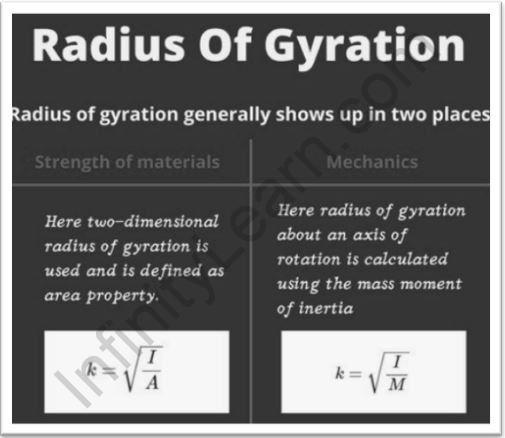Table of Contents
What is radius of gyration and how do you define it? Radius of gyration is the radial distance to a location with the same moment of inertia as the body’s actual distribution of mass if the complete mass of the body were concentrated. It is also known as the radius of a body about the axis of rotation. It is defined mathematically as the root mean square distance of an object’s pieces from its centre of mass or a specific axis, depending on the application. It’s the perpendicular distance between a large object and the rotational axis. The trajectory of a moving point can be illustrated using a body. We can also determine the typical distance that this point travels.
A brief outline
The gyration radius is a measurement of a cross-elastic section’s stability against buckling. In actuality, depending on which axis is being addressed, there are various values for the radius of gyration for a cross-section. It is used to calculate the elastic buckling of columns (also known as the slenderness ratio). The direction in which the has to be regarded as significant and the buckling capacity is often determined by the lowest value. The root-mean-square distance of all electrons from their centre of gravity is the radius of gyration R of a particle. As a result, R may be determined quickly for simple geometrical bodies.
Important concepts
The radius of Gyration Formula
The formula of moment inertia in terms of the radius of gyration is given as follows:
I = mk2 (1)
where I = moment of inertia and m = mass of the body
Accordingly, the radius of gyration is as follows.
K = √I/m (2)
The moment of inertia of any complex body equation (1) can be easily determined by knowing the radius of the gyration, which is measured in millimeters.
Consider a body with n particles, each of which has a mass of m. r1, r2, r3…, rn are the perpendicular distances from the rotating axis. We know that the equation gives the moment of inertia regarding the gyration radius (1). We can calculate the body’s moment of inertia by substituting the values in the equation.
MK2 = M (r12+r22+r32+……+rn2) (3)
M = Total mass of the body
We can deduce from the preceding equation that the radius of gyration can alternatively be characterized as the root-mean-square distance between various body particles and the axis of rotation.
The gyration ratio and the slenderness ratio
The sq. base of the proportion of dormancy to the material region is utilized to work out the span of gyration. The not set in stone from where the cross-sectional region is intended to be accumulated at a point is meant by the worth got from it. This will help you accomplish a similar degree of idleness. It is determined by deciding the slimness of a segment’s cross-sectional region.
Applications of the ratio of gyration
In the discipline of structural engineering, there are a variety of applications
The two-dimensional gyro radius is used in structural engineering to describe the distribution of any cross-sectional area in the body mass around the centroidal axis. It is used in structural engineering to calculate the stiffness of a column. If the two-dimensional gyration principle moments are unequal, the column will buckle around the axis with the smaller principle moment. If we’re talking about engineering and we’re talking about continuous bodies of matter, It will be determined as integral.
In the realm of polymer physics
The term radius of gyration describes the spatial dimensions of a polymer chain. It is possible to receive a polymer chain in a spatial dimension, which refers to a measure of spatial extent, such as height or length. In such instances, gyration radius might be used to solve the problems.
In the realm of mechanics
In terms of the moment of inertia around the axis and the total mass m, the radius of gyration around a particular axis can be determined.

Significance of radius of gyration
- It is enormous in calculating the catching heap of a beam or pressure.
- It’s also useful for adjusting the intensity between the cross-sections of a given section.
- In contrast to the display of many sorts of fundamental forms at the hour of the pressure, the range of gyration is useful.
- The primary inquiry can be completed with a lower estimate of the gyration radius.
- The rotating axis at which the segment catches is revealed by a lower estimate of the radius of gyration.
FAQs
The span of gyration is an estimation that is utilized to inspect how unique primary calculations would act when packed along with a pivot. It's utilized to expect to lock in pressure individuals and pillars.
The length, in inches, millimeters, or feet, is the SI unit for the sweep of gyration. It's the square base of idleness partitioned by the item's region.
The size and state of the body are two factors that influence the calculation of the radius of gyration. It is the positioning and organization of the rotational axis. It also hinges on mass appropriation regarding the body's rotational axis. What is the reason for the gyration range?
What is the global radius of the gyration range unit?
What factors influence the radius of gyration?
Do you want to be an IITian? Well, here is the good news. Infinity Learn has a track record of producing 20% IITians every year. Join our specially curated JEE 2024 course to make your IIT dream come true in the upcoming JEE 2023 exam.



